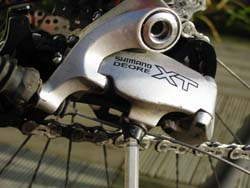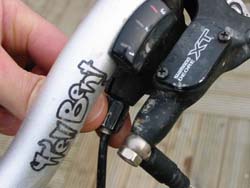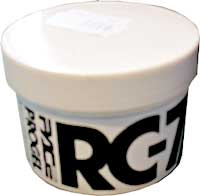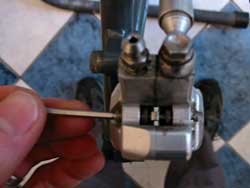Given the conditions that we ask air shocks to work under, it’s a wonder that they last as long as they do. Sure, sometimes you’ll get a rogue one that’ll never hold air but the vast majority sit there and take whatever you can chuck at them. But there’s no point leaving it to chance. While a full service needs to be left to the experts, regular air sleeve maintenance keeps them sweeter for longer. Here’s how to tackle the job for Fox air shocks, probably the most commonly found.
 1. You’ll need whatever tools you need to take the shock out of your bike (usually Allen keys and sockets), plus a screwdriver and some suspension-friendly grease.
1. You’ll need whatever tools you need to take the shock out of your bike (usually Allen keys and sockets), plus a screwdriver and some suspension-friendly grease.
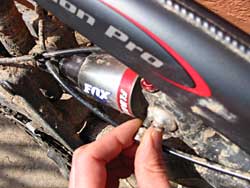 2. Before you start messing around with an air shock, take all the air out first. Sounds obvious, but don’t forget unless you fancy dodging some high-speed shock parts. Use the valve cap back to front to release the air valve. Fox shocks have a negative spring too (it’s inflated from the positive spring automatically), so when you think you’ve got all the air out, lift and compress the back end of the bike a few times and release the air again – there’ll probably be a little bit more.
2. Before you start messing around with an air shock, take all the air out first. Sounds obvious, but don’t forget unless you fancy dodging some high-speed shock parts. Use the valve cap back to front to release the air valve. Fox shocks have a negative spring too (it’s inflated from the positive spring automatically), so when you think you’ve got all the air out, lift and compress the back end of the bike a few times and release the air again – there’ll probably be a little bit more.
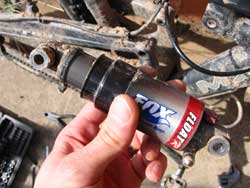 3. With the shock empty, it’s time to take it off the bike. Once it’s out, pull out the aluminium reducers. If you’ve been experiencing any knocks or rattles, now’s a good time to replace the shock bushings and reducers. If all is well, move on to removing the air sleeve.
3. With the shock empty, it’s time to take it off the bike. Once it’s out, pull out the aluminium reducers. If you’ve been experiencing any knocks or rattles, now’s a good time to replace the shock bushings and reducers. If all is well, move on to removing the air sleeve.
 4. Find yourself a vice with suitably soft jaws and carefully clamp the eyelet at the valve and rebound knob end in it. Don’t crush the air valve, rebound knob or lockout lever (if present). Pop a screwdriver or similar implement through the eyelet at the other end, hold it and unscrew the air sleeve anticlockwise. It’s a very fine thread, so it may not appear to be coming undone for a couple of turns, but it is. Residual air pressure will cause it to gently pop off when it’s at the end of the threads.
4. Find yourself a vice with suitably soft jaws and carefully clamp the eyelet at the valve and rebound knob end in it. Don’t crush the air valve, rebound knob or lockout lever (if present). Pop a screwdriver or similar implement through the eyelet at the other end, hold it and unscrew the air sleeve anticlockwise. It’s a very fine thread, so it may not appear to be coming undone for a couple of turns, but it is. Residual air pressure will cause it to gently pop off when it’s at the end of the threads.
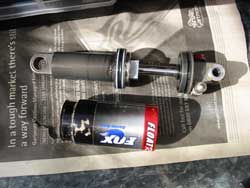 5. With the air sleeve clear of the threads, you can gently slide it back along the shock body. Take the screwdriver out and slide it off. Give everything a good clean and check for damaged or worn seals and O-rings – replace any that look like they need it.
5. With the air sleeve clear of the threads, you can gently slide it back along the shock body. Take the screwdriver out and slide it off. Give everything a good clean and check for damaged or worn seals and O-rings – replace any that look like they need it.
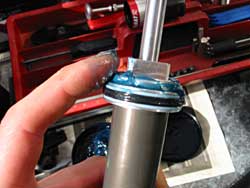 6. Once cleaned up, you need to regrease and reassemble. There are three key areas to grease. The seal, bearing and dust wiper in the air sleeve need a light coating, as do the air sleeve threads and big O-ring at the shock eyelet. Finally, give a good slathering of grease to the bearings and seal on the shock body itself. Leave a good quantity of grease above the body bearing – it’ll gradually work its way through.
6. Once cleaned up, you need to regrease and reassemble. There are three key areas to grease. The seal, bearing and dust wiper in the air sleeve need a light coating, as do the air sleeve threads and big O-ring at the shock eyelet. Finally, give a good slathering of grease to the bearings and seal on the shock body itself. Leave a good quantity of grease above the body bearing – it’ll gradually work its way through.
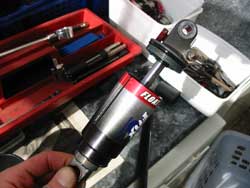 7. All that remains now is to replace the air sleeve and put the shock back on the bike. This may not occur in the order you expect, though. Slide the air sleeve back on the the shock body but don’t push it home. If there was a travel-measuring O-ring on the body, put that back too. You’ll probably find that you can’t push the air sleeve right up to the threads (there’s usually still a bit of air in the negative spring), so you’ll need to use the bike to help.
7. All that remains now is to replace the air sleeve and put the shock back on the bike. This may not occur in the order you expect, though. Slide the air sleeve back on the the shock body but don’t push it home. If there was a travel-measuring O-ring on the body, put that back too. You’ll probably find that you can’t push the air sleeve right up to the threads (there’s usually still a bit of air in the negative spring), so you’ll need to use the bike to help.
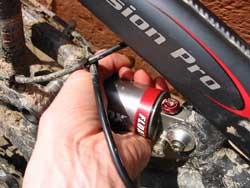 8. Refit the shock to the bike, and then carefully push down on the back of the bike to compress the shock. Once the air sleeve reaches the threads simply turn it clockwise to tighten it back up. Check that the shock mounting bolts are tight, re-inflate the shock to your desired pressure and you’re done.
8. Refit the shock to the bike, and then carefully push down on the back of the bike to compress the shock. Once the air sleeve reaches the threads simply turn it clockwise to tighten it back up. Check that the shock mounting bolts are tight, re-inflate the shock to your desired pressure and you’re done.

